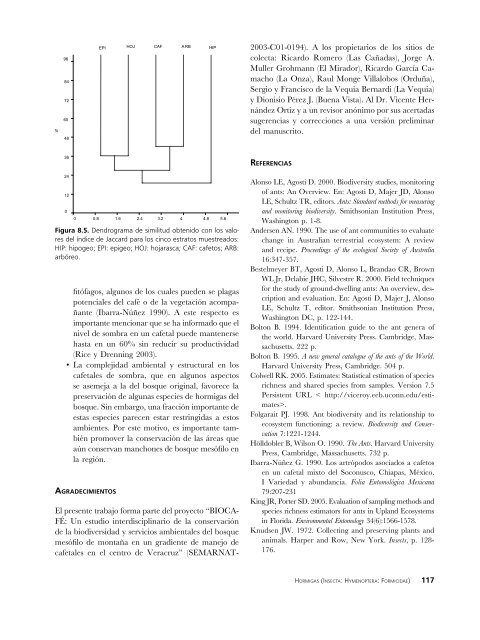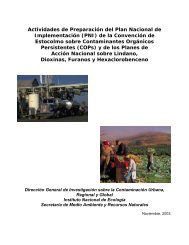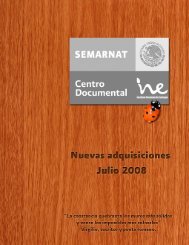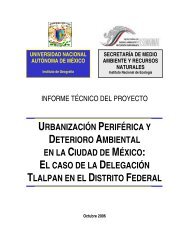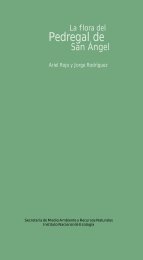Agroecosistemas cafetaleros de Veracruz - Instituto Nacional de ...
Agroecosistemas cafetaleros de Veracruz - Instituto Nacional de ...
Agroecosistemas cafetaleros de Veracruz - Instituto Nacional de ...
Create successful ePaper yourself
Turn your PDF publications into a flip-book with our unique Google optimized e-Paper software.
2003-C01-0194). A los propietarios <strong>de</strong> los sitios <strong>de</strong>colecta: Ricardo Romero (Las Cañadas), Jorge A.Muller Grohmann (El Mirador), Ricardo García Camacho(La Onza), Raul Monge Villalobos (Orduña),Sergio y Francisco <strong>de</strong> la Vequia Bernardi (La Vequia)y Dionisio Pérez J. (Buena Vista). Al Dr. Vicente Hernán<strong>de</strong>zOrtiz y a un revisor anónimo por sus acertadassugerencias y correcciones a una versión preliminar<strong>de</strong>l manuscrito.ReferenciasFigura 8.5. Dendrograma <strong>de</strong> similitud obtenido con los valores<strong>de</strong>l índice <strong>de</strong> Jaccard para los cinco estratos muestreados:HIP: hipogeo; EPI: epigeo; HOJ: hojarasca; CAF: cafetos; ARB:arbóreo.fitófagos, algunos <strong>de</strong> los cuales pue<strong>de</strong>n se plagaspotenciales <strong>de</strong>l café o <strong>de</strong> la vegetación acompañante(Ibarra-Núñez 1990). A este respecto esimportante mencionar que se ha informado que elnivel <strong>de</strong> sombra en un cafetal pue<strong>de</strong> mantenersehasta en un 60% sin reducir su productividad(Rice y Drenning 2003).• La complejidad ambiental y estructural en loscafetales <strong>de</strong> sombra, que en algunos aspectosse asemeja a la <strong>de</strong>l bosque original, favorece lapreservación <strong>de</strong> algunas especies <strong>de</strong> hormigas <strong>de</strong>lbosque. Sin embargo, una fracción importante <strong>de</strong>estas especies parecen estar restringidas a estosambientes. Por este motivo, es importante tambiénpromover la conservación <strong>de</strong> las áreas queaún conservan manchones <strong>de</strong> bosque mesófilo enla región.Agra<strong>de</strong>cimientosEl presente trabajo forma parte <strong>de</strong>l proyecto “BIOCA-FÉ: Un estudio interdisciplinario <strong>de</strong> la conservación<strong>de</strong> la biodiversidad y servicios ambientales <strong>de</strong>l bosquemesófilo <strong>de</strong> montaña en un gradiente <strong>de</strong> manejo <strong>de</strong>cafetales en el centro <strong>de</strong> <strong>Veracruz</strong>” (SEMARNAT-Alonso LE, Agosti D. 2000. Biodiversity studies, monitoringof ants: An Overview. En: Agosti D, Majer JD, AlonsoLE, Schultz TR, editors. Ants: Standard methods for measuringand monitoring biodiversity. Smithsonian Institution Press,Washington p. 1-8.An<strong>de</strong>rsen AN. 1990. The use of ant communities to evaluatechange in Australian terrestrial ecosystem: A reviewand recipe. Proceedings of the ecological Society of Australia16:347-357.Bestelmeyer BT, Agosti D, Alonso L, Brandao CR, BrownWL Jr, Delabie JHC, Silvestre R. 2000. Field techniquesfor the study of ground-dwelling ants: An overview, <strong>de</strong>scriptionand evaluation. En: Agosti D, Majer J, AlonsoLE, Schultz T, editor. Smithsonian Institution Press,Washington DC, p. 122-144.Bolton B. 1994. I<strong>de</strong>ntification gui<strong>de</strong> to the ant genera ofthe world. Harvard University Press. Cambridge, Massachusetts.222 p.Bolton B. 1995. A new general catalogue of the ants of the World.Harvard University Press, Cambridge. 504 p.Colwell RK. 2005. Estimates: Statistical estimation of speciesrichness and shared species from samples. Version 7.5Persistent URL < http://viceroy.eeb.uconn.edu/estimates>.Folgarait PJ. 1998. Ant biodiversity and its relationship toecosystem functioning: a review. Biodiversity and Conservation7:1221-1244.Hölldobler B, Wilson O. 1990. The Ants. Harvard UniversityPress, Cambridge, Massachusetts. 732 p.Ibarra-Núñez G. 1990. Los artrópodos asociados a cafetosen un cafetal mixto <strong>de</strong>l Soconusco, Chiapas, México.I Variedad y abundancia. Folia Entomológica Mexicana79:207-231King JR, Porter SD. 2005. Evaluation of sampling methods andspecies richness estimators for ants in Upland Ecosystemsin Florida. Environmental Entomology 34(6):1566-1578.Knudsen JW. 1972. Collecting and preserving plants andanimals. Harper and Row, New York. Insects, p. 128-176.Hormigas (Insecta: Hymenoptera: Formicidae) 117


